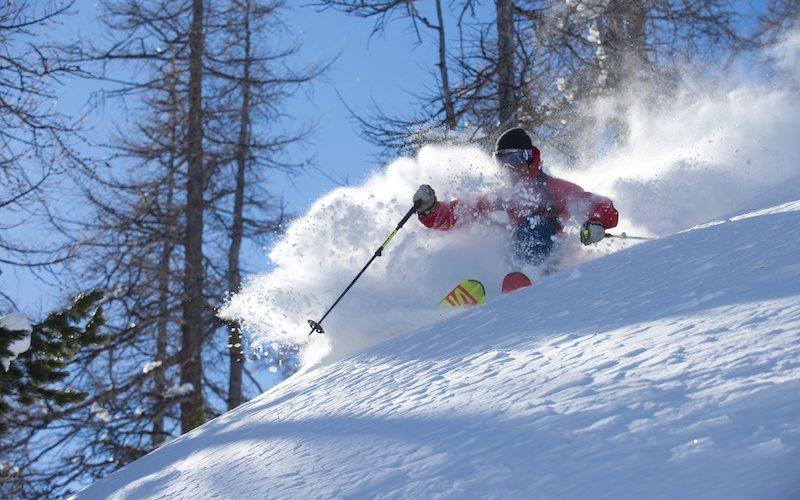So, you’re thinking about doing some freeriding – therefore you’re going to need to get kitted up! Don’t even think about heading off into the off-piste or backcountry without the right gear. Every year hundreds of accidents occur, many of which could easily have been avoided. Stay smart, stay safe.
> YOUR NORMAL GETUP
Your skiing clothes and boots can be the same as you normally use, so no need to spend extra cash on these just yet. If you’re young, trendy and spend a lot of time in the park then you may have invested in some kit that is far too big for you and have your trousers hanging half way down your bum. This may be fine for the park, but be advised: if you’re going freeriding while wearing park kit then you’ll spend most of your time retrieving all the snow from down your pants.
> THE ESSENTIALS
This is the serious stuff that you must not be without: transceiver, backpack, shovel and probe. It’s where your money has to go so don’t cut corners. In case of an avalanche these items enable you to be found and will help you to find your mates. If you’re new to freeriding then book on a course that includes this kit and training in how to use it. The transceiver sends and receives signals, but only if it’s on, only if it’s working and only if you know how to use it. It won’t save your life by itself. There are many on the market so I’m not going to go into which one to buy, but it needs to be a modern digital transceiver. The transceiver allows you to quickly zoom in to close proximity of a buried person. Next comes the probe. This allows you to locate the exact position of a buried person. It’s basically similar to a collapsible tent pole. Again like your transceiver it’s only any good if it actually works and you know how to use it. So if you’ve been given one by your ski buddy, get it out and test it. It will expand up to 2.40m plus depending on the model. Then you’re going to need a shovel to dig out the located person. It needs to be metal, not plastic. Plus a first-aid kit with all the basic essentials, and a map of the area with emergency contact numbers. You’ll also need a backpack to fit it all in. Make sure it’s big enough to accommodate all your kit. Don’t turn up with a Hello Kitty one – get a backpack that is useful and has at least some street cred. The backpack can also be in the form of an airbag. Airbags are expensive and are still not used by everyone, but for most freeriders they are part of the essential kit. An airbag inflates when you pull a trigger and theoretically keeps you closer to the surface of the snow in the event of an avalanche. The trigger can be removed when accessing lifts or helicopters. Don’t leave it in when you’re in the bar or your mate might not be able to resist the temptation to give it a yank.
> THE PLANKS
These are your connection with the mountain and freeriders get pretty attached to these. They want to be fat, fat, fat. Do not go off-piste with a pair of winkle pickers on your feet; they’ll sink and you won’t move. Your skis ideally need to be at least 100mm in the middle. That’s all you need to know. Plain and simple. If you’re going heli-skiing, most operators will include the skis as well as the essentials above as part of the package. Don’t cut corners – get wide skis.
> LES RONDELLS
French for baskets. I’ve included these as most skiers completely neglect this until it’s too late. The baskets on your ski poles need to be big. Do not go off-piste with a pair of tiny race baskets on the end of your poles. You’re going to need to move around the powder, and small baskets in deep powder are as much use as a chocolate fireguard.
> HELMET
One word: essential!
> THE EXTRAS
Powder tracers can be useful for finding skis. They are long pieces of fabric that attach to the skis and roll up and slot into your ski pants. If you’re into gadgets you can now attach ski-retrieval devices to your skis. These work in the same way as a transceiver but on a different frequency. If you’ve taken to freeriding and got the bug then you’ll probably end up wanting more powder. Start by investing in a backpack with carrying straps for skis so you can access backcountry that requires a hike. More hiking = less people = more powder.
To access deep backcountry and more untracked powder you may choose to invest in touring bindings and skins, and if hiking up the mountain begins to overtake the sliding down then you will want to look into a pair of freeride boots with walk mode and rubber soles to provide more grip when scrambling or climbing on rock. Extreme freeriders will be kitted out with, amongst other items, ropes, harnesses, crampons, ice axes, maps, compass, satellite navigation, emergency torch and of course a spare pair of underpants!
Photo: Polly Baldwin, Dynamicpictures.com
Riders: Team Snoworks




